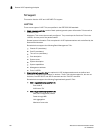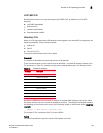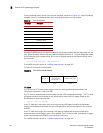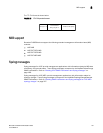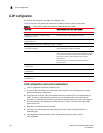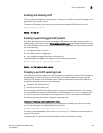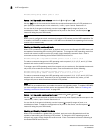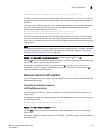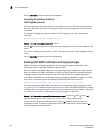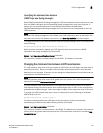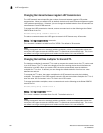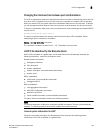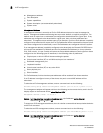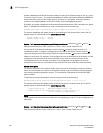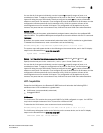
196 Brocade ICX 6650 Administration Guide
53-1002600-01
LLDP configuration
8
Use the show lldp command to view the configuration.
Specifying the maximum number of
LLDP neighbors per port
You can change the maximum number of LLDP neighbors for which LLDP data will be retained for
each port. By default, the maximum number is four and you can change this to a value between
one and 64.
For example, to change the maximum number of LLDP neighbors to six, enter the following
command.
Brocade(config)#lldp max-neighbors-per-port 6
Syntax: [no] lldp max-neighbors-per-port <value>
Use the no form of the command to remove the static configuration and revert to the default value
of four.
The <value> variable is a number from 1 to 64. The default is number of LLDP neighbors per port
is four.
Use the show lldp command to view the configuration.
Enabling LLDP SNMP notifications and Syslog messages
SNMP notifications and Syslog messages for LLDP provide management applications with
information related to MIB data updates and general status.
When you enable LLDP SNMP notifications, corresponding Syslog messages are enabled as well.
When you enable LLDP SNMP notifications, the device will send traps and corresponding Syslog
messages whenever there are changes to the LLDP data received from neighboring devices.
LLDP SNMP notifications and corresponding Syslog messages are disabled by default. To enable
them, enter a command such as the following at the Global CONFIG level of the CLI.
Brocade(config)#lldp enable snmp notifications ports e 1/1/1 to 1/1/2
The above command enables SNMP notifications and corresponding Syslog messages on ports
1/1/1 and 1/1/2. By default, the device will send no more than one SNMP notification and Syslog
message within a five second period. If desired, you can change this interval. Refer to “Specifying
the minimum time between SNMP traps and Syslog messages” on page 197.
Syntax: [no] lldp enable snmp notifications ports ethernet <stack-unit>/<slot>/<port>| all
Specify the ethernet port in the <stack-unit>/<slot>/<port> format. Stack-unit is 1.
You can list all of the ports individually, use the keyword to to specify ranges of ports, or a
combination of both. To apply the configuration to all ports on the device, use the keyword all
instead of listing the ports individually.



